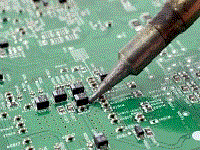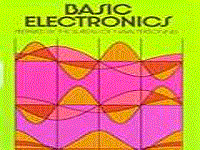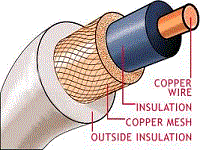Compass and Alternating Current
Up to this point, only direct current examples have been used. What happens with the use of alternating current? The Figure below shows a magnet close to a conductor carrying alternating current at a frequency of 1 hertz.
Compass
and conductor with ac.
The compass needle will swing toward the east part of the compass (down) as the current goes positive, as represented in the figure above view(A). (The sine wave of the current is shown in the lower portion of the figure to help you visualize the current in the conductor.)
In the figure above view(B), the current returns to zero, and the compass needle returns to magnetic north (right). As the current goes negative, as in the figure view(C), the compass needle swings toward the west portion of the compass (up). The compass needle returns to magnetic north as the current returns to zero as shown in the figure view(D).
This cycle of the current going positive and negative and the compass swinging back and forth will continue as long as there is alternating current in the conductor.
If the frequency of the alternating current is increased, the compass needle will swing back and forth at a higher rate (faster). At a high enough frequency, the compass needle will not swing back and forth, but simply vibrate around the magnetic north position. This happens because the needle cannot react fast enough to the very rapid current alternations. The compass (a simple meter) will indicate the average value of the alternating current (remember the average value of a sine wave is zero) by vibrating around the zero point on the meter (magnetic north). This is not of much use if you wish to know the value of the alternating current. Some device, such as a rectifier, is needed to allow the compass to react to the alternating current in a way that can be useful in measuring the current.
RECTIFIER FOR AC MEASUREMENT
A rectifier is a device that changes alternating current to a form of direct current. The way in which this is done will be covered later in this training series. For now, it is necessary to know only the information presented in the figure below.
Rectifier-action.
The figure above shows that an alternating current passed through a rectifier will come out as a "pulsating direct current.
" What happens to the compass now? The next figure below answers that question.
Compass and conductor rectified ac.
When the compass is placed close to the wire and the frequency of the alternating current is high enough, the compass will vibrate around a point that represents the average value of the pulsating direct current, as shown in the figure above.
Become a loyal member to our site. It's free!
Site Search


Translate your page
If English is not your first language you can Translate the text on this page to any one of the languages found in the drop down menu. Select your language from the list for an instant translation.
Looking for something unique for your project? Choose from the drop down menu for quick access to the item you seek.
Related Pages
Become an Electronics Technician
Convert most anything with this utility
Find your wire and cable here!
Sponsored Sites


If you like this site please pay it forward. Donations are welcome.















